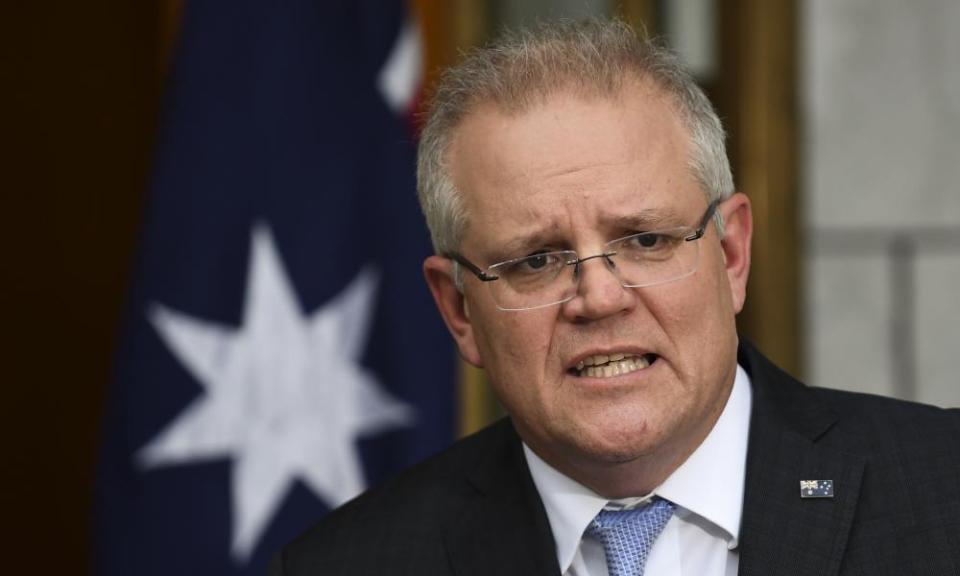Victorian workers offered $1,500 pandemic leave payment, but unions and business call for more

Unions have cautiously welcomed the introduction of a pandemic leave disaster payment of $1,500 a fortnight for workers without sick leave who need to self-isolate after a positive Covid-19 test, but said it did not address “the full scale” of the crisis in Victoria.
Scott Morrison announced the payment – which will be jointly funded with states that have declared a state of disaster – on Monday after big business and Australian unions teamed up to demand a more comprehensive right to paid leave to cover workers nationwide.
A further announcement is expected on Tuesday about Australian Defence Personnel assisting with compliance activities in Victoria, as pressure grows on the federal government to help fight Victoria’s Covid-19 crisis.
Related: Retail stores closed and 250,000 Victorians stood down under stage 4 Covid restrictions
The prime minister told reporters in Canberra the new payment would be available to all workers without sick leave in Victoria, and would be offered to any state that declared a state of disaster.
The new $1,500 payment is intended to “supplement and support” Victoria’s existing payment system by covering the fortnight of self-isolation after a positive result. Victoria has been offering the same sum to workers with no sick leave or other income, but the scheme was criticised as inadequate by unions and business, which noted it had “minimal take up over recent weeks”.
Victoria will now pick up the bill only for temporary visa-holders who need the payment, while the commonwealth will pay for Australian citizens and residents.
The federal government’s payment would be available if people need to self-isolate multiple times, Morrison said. “[This] means that those who need to self-isolate as a result of an instruction by a public health officer – there is no economic reason for you to go to work.”
Victoria will also continue to pay $300 for workers awaiting test results.
Morrison specified the $1,500 was a “disaster payment” that was not available to residents of other states, because “the number of cases in other states, and the way that’s being handled” had not required them to declare a disaster.
The Australian Council of Trade Unions welcomed the announcement, but secretary Sally McManus said it “does not address the full scale of the problems which fully funded paid pandemic leave would address”.
“This payment will mean that nearly all full-time workers who are forced to rely on it will take a pay cut while they isolate,” she said.
“This will mean that a financial penalty still remains; this just weakens our Covid-19 defences.”
McManus noted workers would have to call a 1800 phone number to apply, rather than receiving pay through their employer as usual.
In a letter to the industrial relations minister, Christian Porter, the Business Council of Australia and ACTU argued for a more comprehensive system of leave “funded by the federal government and where necessary the relevant state governments”.
The letter argued that many workers “have no or inadequate sick leave” and continued to attend work while infectious or at risk because “the cost of isolation can be particularly burdensome”.
Although some employers had introduced paid pandemic leave, “not all are able to do so given the cost, especially in the current circumstances where workers are often required to isolate and get tested on multiple occasions”, the letter said.
The peak bodies acknowledged the Victorian government’s $1,500 hardship payments, but said the take-up had been “minimal” in recent weeks due to “inadequate” mechanisms to administer payments.
They asked for two weeks of paid pandemic leave for all workers, in line with changes the Fair Work Commission granted to workers in the residential aged care sector.
Last week, Morrison said he had asked Porter to conduct consultations “in recent days”, despite unions lobbying for paid pandemic leave since mid-March.
Business groups representing smaller employers, such as the Australian Chamber of Commerce and Industry, have resisted paid pandemic leave, although the Australian Industry Group has expressed support for “government-funded payments”.
Earlier on Monday Frydenberg suggested eligibility criteria for jobkeeper wage subsidies could be eased to help struggling businesses, including those in Victoria, by allowing businesses to show the required downturn in either the June or September quarter.
“There may be some businesses that didn’t have turnover that was down in the June quarter, so for example in May they had strong retail sales but obviously now we’re in August and over the course of July these businesses have been badly hit,” he told Radio National.
“So we’re looking at the eligibility question for those because we don’t want businesses that have been really badly hit through the September period but maybe have not met the 30% threshold in the June period, we want to make sure we can get support to them as well.”
Morrison did not rule out re-evaluating other aspects of jobkeeper, such as cutting the rate from $1,500 to $1,200, before it enters its next phase on 28 September.
The opposition leader, Anthony Albanese, said paid pandemic leave “should be announced immediately as a priority of the national government”.
Federal Labor has also increased pressure on the government to allow parliament to return in the final week of August to debate its handling of the coronavirus crisis, including its responsibility for aged care and the Covidsafe app.
Morrison said he would announce arrangements on Tuesday for its return.

 Yahoo News
Yahoo News 